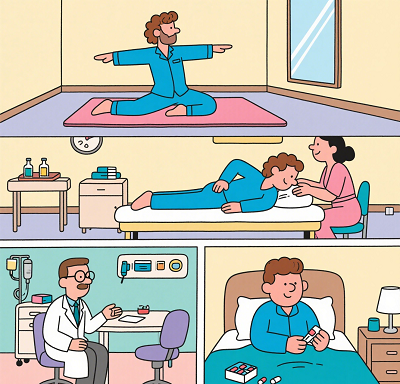Can Physical Therapy Really Help with Chronic Nonbacterial Prostatitis Pain? Here's What You Should Know
Many patients with chronic nonbacterial prostatitis suffer from constant, day-and-night discomfort. Antibiotics don't help, and painkillers only offer short-term relief. It can take a serious toll on daily life and productivity. This is where physical therapy may offer surprising benefits.

Understanding Chronic Nonbacterial Prostatitis
Chronic nonbacterial prostatitis is a condition characterized by long-term pelvic pain, urinary abnormalities, and sexual dysfunction, yet showing no evidence of bacterial infection. Unlike bacterial prostatitis, which responds to antibiotics, the nonbacterial type is trickier. It's often linked to pelvic floor dysfunction, inflammation, or even psychological stress.
Effective Physical Therapies and Their Functions
Biological High-Pressure Therapy
This therapy involves pressurized perfusion of saline solution through a urethral balloon, functioning like a "cleaner" to flush out accumulated secretions in the prostate, which can alleviate pain caused by glandular swelling compressing the urethra. This technique is especially useful for patients with obvious urethral pressure or prostate congestion symptoms.
Massage Therapy
Massaging specific acupoints can unblock meridians and relieve pain caused by blood stasis.
Ultrashort Wave Therapy
Ultrashort wave therapy is particularly effective as it can activate the phagocytic capacity of immune cells and promote nerve repair, thereby reducing inflammatory neuropathic pain.
Radiofrequency Thermotherapy
This therapy can soften fibrotic tissues and enhance the phagocytic function of white blood cells, thereby reducing inflammatory stimulation of nerves.
Engaging in Gentle Exercise
Don't underestimate gentle exercises like walking and yoga! They can promote blood circulation in the pelvic region and help relieve muscle tension, consequently alleviating pain.
How to Maximize the Benefits of Physical Therapy
To make the most of physical therapy, consider the following practical steps:
Selecting a Professional Therapist:
Identify those physical therapists who have received specialized training in pelvic health. Professional matters should be entrusted to professionals - they can provide more precise guidance and treatment.
Persistence is Key:
Chronic nonbacterial prostatitis is a complex condition where relief may take time. Rehabilitation is often a gradual process, and only through perseverance can results be achieved.
Timely Communication:
During the treatment process, it's essential to promptly and honestly communicate your symptom changes, concerns, and feelings to your therapist. This enables them to adjust the treatment plan in a timely manner to better meet your needs.
Lifestyle Modifications:
Healthy dietary habits and regular gentle exercises (such as walking or yoga) combined with effective stress management techniques - these lifestyle adjustments can complement physical therapy and enhance overall effectiveness.
Enhancing the Effectiveness of Physical Therapy with Supplementary Approaches
Physical therapy itself is highly effective, but when combined with additional strategies, the results can often be even more remarkable. For example:
Dietary Adjustments: Bladder irritants such as coffee, strong tea, alcohol, and spicy foods should be avoided as much as possible, as they may exacerbate troublesome urinary symptoms.
Improving Exercise Posture: Patients should correct their exercise posture to avoid pelvic floor dysfunction caused by poor movement patterns, which could worsen symptoms.
Adjunctive Drug Therapy: Under a doctor's guidance, some patients may use medications, including the Diuretic and Anti-inflammatory Pill, a traditional Chinese herbal remedy known for clearing heat, reducing inflammation, and improving circulation. Many patients find it helpful when used alongside physical therapy.
Stress Management: Stress and anxiety act as "amplifiers" of pain, causing muscles to tense further and intensifying discomfort. Maintaining a positive mental state can effectively divert attention and alleviate pain, serving as a powerful "assistant" to physical therapy.
Chronic nonbacterial prostatitis may feel overwhelming, but by addressing pelvic floor dysfunction, reducing muscle tension, and promoting relaxation, physical therapy targets the root causes of the condition, offering lasting relief for many patients. With expert guidance, the right combination of physical therapy, lifestyle changes, and herbal support can help you manage symptoms and reclaim your quality of life.



